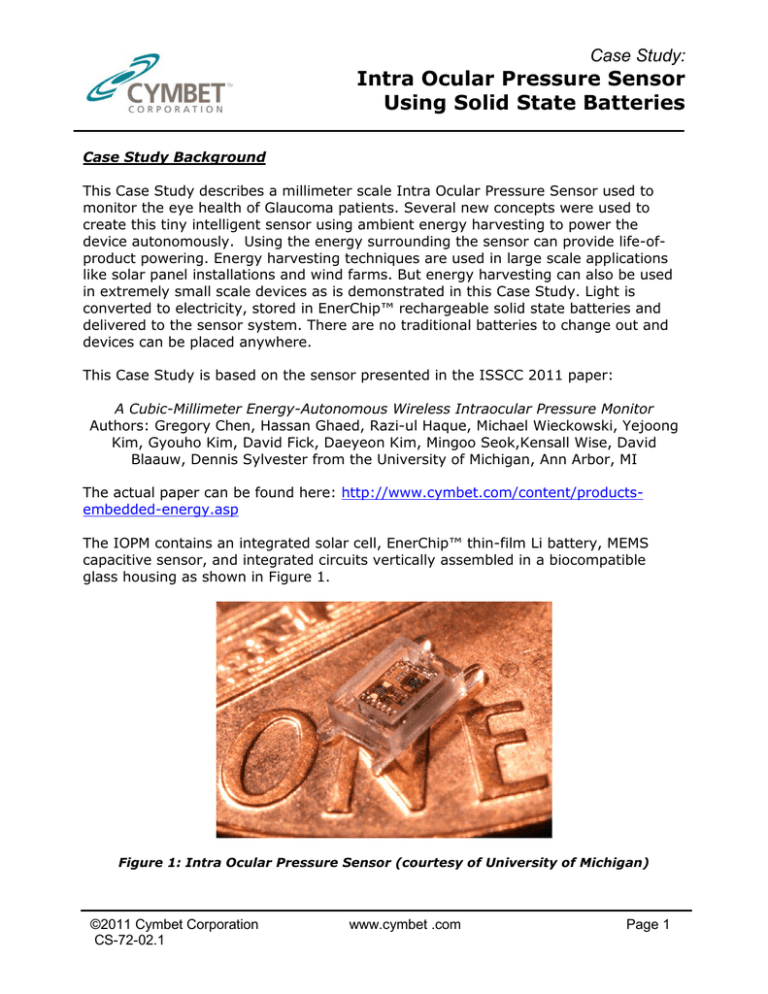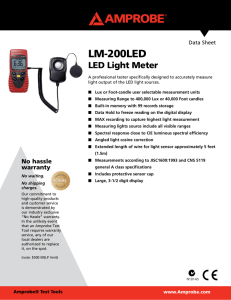Case Study: Intra Ocular Pressure Sensor Using Solid State Batteries
advertisement

Case Study: Intra Ocular Pressure Sensor Using Solid State Batteries Case Study Background This Case Study describes a millimeter scale Intra Ocular Pressure Sensor used to monitor the eye health of Glaucoma patients. Several new concepts were used to create this tiny intelligent sensor using ambient energy harvesting to power the device autonomously. Using the energy surrounding the sensor can provide life-ofproduct powering. Energy harvesting techniques are used in large scale applications like solar panel installations and wind farms. But energy harvesting can also be used in extremely small scale devices as is demonstrated in this Case Study. Light is converted to electricity, stored in EnerChip™ rechargeable solid state batteries and delivered to the sensor system. There are no traditional batteries to change out and devices can be placed anywhere. This Case Study is based on the sensor presented in the ISSCC 2011 paper: A Cubic-Millimeter Energy-Autonomous Wireless Intraocular Pressure Monitor Authors: Gregory Chen, Hassan Ghaed, Razi-ul Haque, Michael Wieckowski, Yejoong Kim, Gyouho Kim, David Fick, Daeyeon Kim, Mingoo Seok,Kensall Wise, David Blaauw, Dennis Sylvester from the University of Michigan, Ann Arbor, MI The actual paper can be found here: http://www.cymbet.com/content/productsembedded-energy.asp The IOPM contains an integrated solar cell, EnerChip™ thin-film Li battery, MEMS capacitive sensor, and integrated circuits vertically assembled in a biocompatible glass housing as shown in Figure 1. Figure 1: Intra Ocular Pressure Sensor (courtesy of University of Michigan) ©2011 Cymbet Corporation CS-72-02.1 www.cymbet .com Page 1 Case Study: Intra Ocular Pressure Sensor Project Design Requirements The power storage design requirements for this Intra Ocular Pressure Sensor were: 3 1. The IOPM volume is limited to 1.5mm . The Battery must have a small device footprint of 1.5mm x 1.3mm by 150 microns. 2. The battery must be a stackable with other Integrated Circuits and use standard wire bond attachment. 3. The battery must work in ultra-low power operation with energy harvesting. 4. The IOPM is surgically implanted in the anterior chamber of the eye, and the battery must last the life of the sensor. 5. The battery must support the required millimeter antennas which use lower received power and higher transmission frequency, both increasing microsystem power. 6. The IOPM harvests solar energy that enters the eye through the transparent cornea to achieve energy autonomy and charge the battery. 7. The circuits powered by the battery include: a wireless transceiver, capacitance to digital converter (CDC), DC-DC switched capacitor network (SCN), microcontroller (μP), and memory fabricated in 0.18μm CMOS. 8. Battery must have less than 2% self discharge per year Design Solution The IOPM shown in the Figure 1 photo is shown diagrammatically in Figure 2. The device is a 4 layer stack encapsulated in a bio-compatible glass enclosure. The first layer is the MEMS pressure sensor, with a 1uAh rechargeable EnerChip solid state battery sitting on top. The Processor with memory, power management and sensor A/D converter sits on the EnerChip. The top layer is the solar cell and wireless transceiver. All the layers in this case were wire bonded together for electrical connectivity. Figure 2: IOPM Layers Block Diagram ©2011 Cymbet Corporation CS-72-02.1 www.cymbet.com Page 2 Case Study: Intra Ocular Pressure Sensor Technical design information for applications such as the Intra Ocular Pressure Sensor can be found in the following Cymbet.com Design Center website pages: • Application information for using EnerChip Solid State Battery bare die can be found at http://www.cymbet.com/design-center/embedded-energy.php • Datasheets with specifications for EnerChip bare die can be found at: http://www.cymbet.com/products/enerchip-solid-state-batteries.php • Application Notes for Energy Harvesting based solutions can be found at: http://www.cymbet.com/design-center/application-notes.php AN-1008: Benefits of Using EnerChips Instead of Coin Cells and Super Capacitors http://www.cymbet.com/design-center/application-notes/an1008.php AN-1036: Using the EnerChip CC in Energy Harvesting Designs http://www.cymbet.com/design-center/application-notes/an-1036.php AN-1050: EnerChip Energy Harvesting for the TI Launch Pad http://www.cymbet.com/design-center/application-notes/an-1050.php Evaluating Cymbet EnerChip Solutions for Your Next Project This Case Study demonstrates how the design team at University of Michigan used EnerChip Solid State Battery bare die to create a breakthrough millimeter-scale Intra Ocular Pressure Sensor. Cymbet is working around the world with product development teams to integrate Cymbet EnerChip solutions into their new innovations. In order to get started with Cymbet EnerChips it is best to obtain an Evaluation Kit. A wide range of kits is listed here: http://www.cymbet.com/products/evaluationkits.php For additional information call Cymbet Applications Engineering at +1-763-633-1780 or use the Support form on Cymbet.com. ©2011 Cymbet Corporation CS-72-02.1 www.cymbet.com Page 3


